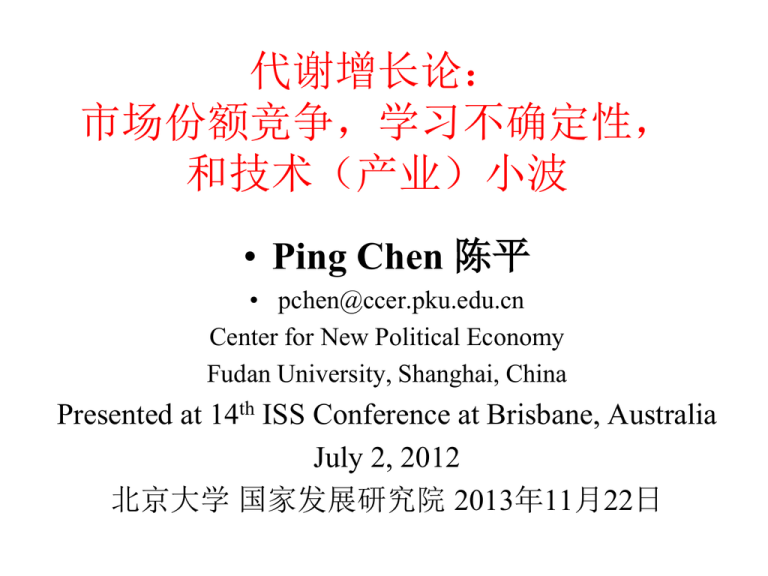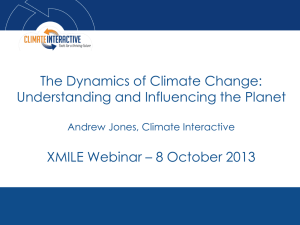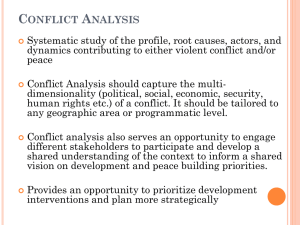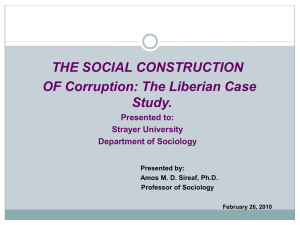陈平代谢增长理论 - 北京大学国家发展研究院NSD
advertisement

代谢增长论: 市场份额竞争,学习不确定性, 和技术(产业)小波 • Ping Chen 陈平 • pchen@ccer.pku.edu.cn Center for New Political Economy Fudan University, Shanghai, China Presented at 14th ISS Conference at Brisbane, Australia July 2, 2012 北京大学 国家发展研究院 2013年11月22日 • • • • • • • 灵感的由来:观潮而思四十五 年 文革长征:太原重机厂的调查(1967年春)》西方禁运:劳 动分工受市场规模限制 李约瑟,费正清,裴宜理,黄宗智,和普里戈金》用物理学 方法研究历史(1979-85) 布鲁塞尔学派:生命起源》蚂蚁的劳动分工模型(1977-81) 》现代劳动分工与东西方文明的分岔》人和蚂蚁的差别? 日本物理学家的观察》引入文化因子(1983-87) 从自组织》经济复杂系统》演化动力学》复杂演化经济学 理论生态学的复杂性佯谬》亚当-斯密悖论》一般斯密原理( 2002,2005) 中国模式的辩论》挑战内生增长论和知识积累伦》 • 代谢增长论(2012-14) 修正经济学的基本观念 • 市场竞争的本质:价格竞争还是市场份额竞 争? • 价格机制:边际定价,成本加成定价,还是 策略定价(strategic pricing)? • 技术进步的基本模式:可预测的风险和不可 预测的不确定性? • 经济发展的基本动力是知识扩散,还是资源 与市场的开发、竞争与淘汰? • 经济决策是完全信息下的理性优化决策,还 是陌生机遇下的试错和模仿? 经济学的基本问题 • (1)经济增长是否受资源约束(马尔萨斯问 题)?》 • 新古典人性的自私贪婪假设=资源无限》 线性 优化模型 • 资源有限》演化经济学的非线性竞争演化模 型 • (2)如何描写技术更新对经济发展的作用? • 新古典经济学:噪声驱动》连续变化》优化 过程 李约瑟问题-华勒斯坦佯谬 》 劳动分工和东西方文明分岔》 代谢增长论》产业(文明)兴衰 • • • • 生态模型引入经济学(Samuelson 1971) 文化因子引入学习竞争(Chen 1987) 资源约束》市场份额竞争(陈平 2002) 斯密悖论》复杂系统》稳定性与复杂性的矛 盾(Chen 2005) • 逻辑斯蒂小波》创造性毁灭》知识新陈代谢 》挑战内生增长论(Chen 2012, 2014) 一石五鸟 • (1)生态学》引入行为因素 • (2)个人主义与集体主义的竞争策略与赶超模式 • (3)经济学》价格竞争转为市场份额竞争,边际 定价、成本加成定价,与策略定价 • (4)经济学与复杂科学》重新定义国富= • 规模经济+范围经济(资源多样性)》新的绿色增 长方式 • (5)一般斯密原理:劳动分工受市场规模、资源 种类、环境涨落的限制 • (6)经济动力学统一理论(微观,中观,宏观, 制度)的共同模块》生命周期的小波模型 • (7)虚拟经济重新生态化》社会人与经济生态 Fundamental Causes of Asian Emergence: Two Competing Perspectives • Neo-classical perspective: nothing new > tech diffusion + high investment > export-led growth > convergence in growth and culture • Evolutionary perspective: ecological crisis + new wave of industrial revolution > structural changes in economies and organization > rise of East Asia & decline of West • Theoretical challenge: which growth theory is relevant in the global age ? Which Growth Theory Is Relevant to Modern History? • Average Annual GDP Growth Rate (1913-2001) • ----------------------------------------------------------------------------Period WEuro EEuro Asia US fUSSR Japan China --------------------------------------------------------------------------------------------------1913-50 1.19 0.86 0.82 2.84 2.15 2.21 -0.02 1950-73 4.79 4.86 5.17 3.93 4.84 9.29 5.02 1973-2001 2.21 1.01 5.41 2.94 -0.42 2.71 6.72 --------------------------------------------------------------------------------------------------Source: Maddison (2007), UN Statistics Uneven Growth in Globalization (Annual Real GDP growth rate per decade) • • • • • • • • • • • • • • Period 1970s 1980s 1990s 2000s -------------------------------------------------------------------China 6.2 9.3 10.4 10.5 Japan 3.8 4.6 1.2 0.7 US 3.2 3.2 3.4 1.6 Germany 2.9 2.3 1.9 0.9 East Asia 4.4 5.5 3.3 4.0 Latin America 6.1 1.5 3.2 3.1 East Europe 4.4 2.3 -2.0 4.3 West Europe 3.1 2.3 2.1 1.1 Australia & NZ 2.8 2.9 3.6 3.0 World 3.8 3.1 2.8 2.5 -----------------------------------------------------------------(Data Source: UN Statistics) Main Issues in Economic Theory • 1. Equilibrium vs. non-equilibrium growth theory > convergence /divergence vs. rise & fall • 2. Concept of knowledge and nature of technology > static vs. evolutionary perspective • 3. Population dynamics of creative destruction > resource constrains and technology wavelets • 4. Learning competition and culture strategy > different growth mode in West and East > labor-saving vs. resource-saving technology • 5. East Asia and China experience > technology cycle, mixed economy, and helping hand Neoclassical Growth Theory: Convergence vs. divergence story • Exogenous growth theory (Solow 1956): Constant Returns > Convergence • Endogenous growth theory (Romer 1990): Learning by doing = Knowledge Accumulation (Arrow 1962) > Increasing Returns >Divergence > Persistent divide between Rich and Poor • Puzzle: how to understand rise and fall of civilizations and great powers? • Metabolic growth theory (Chen 1987, 2005, 2010, 2012) Economic Insight and Theoretical Modeling • Adam Smith > division of labor is limited by market extent • Marshall > economics should be close to biology and dynamics • Hayek > knowledge is a discovery process • Schumpeter > development means creative destruction • Frank Knight > risk and uncertainty in market Methodological Issue: How to Describe Technology Advancement? • Technology as random shock: Solow residual, RBC school > macro econometrics • Technology as continuous trajectory: knowledge capital, increasing returns > • Technology as logistic growth turned into logistic wavelets > population dynamics for Schumpeter’s creative destruction Unlimited vs. Limited (Logistic) Growth a1=0.6, a2=1, a3=1.4; K=4, Rlogis=4.0 Theoretical Issue: What Determines the Size of Market Extent? • Smith theorem: division of labor is limited by market extent = market niche > depends on resource and technology > logistic growth = varying returns to scale > source of nonlinearity & complexity • Neoclassical production function > ignores resource constraints > unlimited (exponential) growth > equilibrium thinking and consumerism > root of ecological crisis + financial crisis Evidence of Logistic Growth: US Automobile Industry (Output as Percentage of GDP) R a t io o f T o t a l A u t o S a le t o G D P 5 ra t io (% ) 4 3 2 1 0 1900 1910 1920 1930 1940 1950 1960 1970 Technology Wavelets, Growth Cycles, and Creative Destruction in Species Competition Model L o g is t ic C o m p e t it io n 2 .5 p o p u la t io n 2 1 .5 1 0 .5 0 0 100 200 300 t im e 400 500 China Approach in Adapting Tech Cycle: Helping Hand at Varying Stages • I (initial stage). > strategic planning, technology import, tech transfer from science & defense sector to civilian industry • II (take-off stage). > open competition under mixed economy, selective opening in industrial park, government matching fund for FDI, market regulation for virtuous competition • III (mature stage). > breaking monopoly + encouraging innovation • IV (transition stage). > assistance for close-down obsolete industry, re-education of laid-off workers, reform policy & stabilizing policy Observable Patterns in Changing Return to Scale • Cobb-Douglas production function > static (fixed) return to scale • Logistic growth > logistic curve > dynamic return to scale > dynamic increasing returns (first half) + decreasing returns (second half) + constant returns (infinite future) to scale • Species competition > logistic wavelets > rise & fall of wavelets Origin of Culture Diversity: Culture As Learning Strategy for Emerging Markets &Resources • Equilibrium thinking > culture convergence > universal value and institute • Non-equilibrium thinking > culture diversity > varying strategies for adapting to changing environment > coexistence of individualist and collectivists species Why East (Asia and China) Is Different from West? • Two modes of division of labor in history: • East > resource-saving/labor-intensive technology > agriculture revolution > rise of East • West > labor-saving/resource-intensive technology > industrial revolution > rise of West • • • • Crises of modern civilization: Global warming > ecological crisis Job crisis > machine crowding out people What is the impact of information revolution? Wallerstein Paradox and Causes of Culture Diversity • Historical paradox > Why resource-rich European needs more existence space while highly populated China needs more labor during civilization bifurcation about 14-17th century? • Ecological constraints for growth > resource/population ratio > strategic choice under uncertainty • Culture orientation shaped by environment > labor saving vs. resource saving technology > individualism vs. collectivism > path dependence in development process Three Types of Learning Strategies and Risk Attitudes • Learning by doing (Smith: pin-making) > knowledge accumulation > gradual change > risk-neutral culture • Learning by trying (pioneers in fire, electricity) > knowledge creation > abrupt change > risk-taking culture • Learning by imitating (late-comers) > catch-up game > risk-averse culture • Modeling approach: from static theory of risk aversion to nonlinear dynamics of varying risk behavior Culture Factor and Learning Strategy in Facing New and Uncertain Technology • Behavioral factor R(a) R (r , a, n N ) r (1 a n ) N • 0<a<1 • Collectivism = risk averse • -1<a<0 • Individualism =risk taking Resource, Culture, and Learning Strategy • Individualistic species needs larger existence space. n * a0 n * a0 n * a0 • European pastoral life > labor-saving but resource-consuming economy • Chinese grain-production> resource-saving but labor-intensive economy Competitive Exclusion & Coexistence in Two Species Model • The condition of co-existence (1 r1 (1 ) s1 N 1 (1 r2 s2 N 2 )( 1 a 1 r1 s1 N 1 ) N2 N1 r1 )( 1 s1 N 1 (1 a 2 r2 ) s2 N 2 r2 ) s2 N 2 • Two collectivists cannot coexist; • Two individualists may coexist; • No. of species No. of resources Land Use in 1993 (Maddison 1998, p.28) • ----------------------------------------------------------------------------------------------• Region Total (m hc) Arable (%) Pop (m) ArabLand per head (hc) • ----------------------------------------------------------------------------------------------China 959.7 10 1178.4 0.08 • Japan 37.8 11.8 124.8 0.04 • India 328.8 51.6 899.0 0.19 • • • • • 487.7 980.9 2240.3 997.6 771.4 27.8 19.1 10.3 4.6 6.0 506.9 239.2 293.0 28.4 17.8 0.26 0.73 0.79 1.58 2.62 Europe US USSR Canada Australia • Resource intensity: West mode ~ 10 times or more of East mode Catch-Up Game between Innovators and Imitators • Complex patterns of rise and fall between individualist and collectivism • Collectivist will catch and win by imitating existing technology • Individualist will survive by faster innovation & learning by trying emerging technology • Collectivist has greater stability under fluctuating environment • A mixed system of individualists and collectivists is more stable than a pure system of two individualists 时代变迁与规范更新 • 罗马俱乐部报告》增长的极限》系统工程 兴起(196?) • 数学的突破与质疑:突变,分岔、混沌( 1970’s)》 生物学家怀疑(Gould) • 资本主义与社会主义竞争谁胜谁负?》普 里戈金不信(1986),苏东瓦解后赞赏( 1992)。 • 劳动分工的优化模式(杨小凯)与演化模 式(陈平)(1990)。 • 金融危机与中国崛起》接受代谢增长论 方法论问题 • • • • 真实经济与货币经济 均衡与非均衡的机制 线性与非线性思维 理论与计算机模拟 • 萨缪尔森问题(1995):陈平工作是否会产生新的规 范(paradigm)? • 普里戈金问题:混沌产生有序》什么的新的秩序? • 陈平探索:从复杂经济学》演化经济学》 • 代谢经济学 Conclusion • Growth is an evolutionary dynamics in non-equilibrium open system, which is more complex than optimization process in equilibrium closed system • Population dynamics is a useful framework for economic dynamics, which is shaped by ecological constraints and market-share competition • Metabolic growth theory describes essential features of creative destruction in modern economy. Logistic wavelet is a better mathematical representation for technology progress and growth cycles than harmonic cycle and random shocks in neoclassical economics. • Liberalization policy in Washington Consensus is misleading for emerging and transition economies, since it ignores the uncertainty and sunk costs in technology advancement and uneven globalization References • • • • • • • • • • Chen, Ping, "Origin of the Division of Labor and a Stochastic Mechanism of Differentiation," European Journal of Operational Research, 30, 246-250 (1987). Chen, Ping, “Evolutionary Economic Dynamics: Persistent Business Cycles, Disruptive Technology, and the Trade-Off between Stability and Complexity,” in Dopfer, Kurt, ed., The Evolutionary Foundations of Economics, Chapter 15, pp.472-505, Cambridge University Press, Cambridge, (2005) . Chen, Ping, Equilibrium Illusion, Economic Complexity, and Evolutionary Foundation of Economic Analysis,” Evolutionary and Institutional Economics Review, 5(1), 81-127 (2008). Chen, Ping, Economic Complexity and Equilibrium Illusion, Routledge, London (2010). Arrow, Kenneth J. "The Economic Implications of Learning by Doing", Review of Economic Studies, 39, 155 (1962). Maddison, Angus, Chinese Economic Performance in the Long Run, OECD, Paris (1998). Solow, Robert M. "A Contribution to the Theory of Economic Growth," Quarterly Journal of Economics, 70(1), 65-94 (1956). Romer, Paul M. “Increasing Returns and Long-Run Growth,” Journal of Political Economy, 94, 1002-38 (1986). Rostow, Walt W. The Stages of Economic Growth, 3rd ed., Cambridge University Press, Cambridge (1990). Prigogine, Ilya, Allen, Peter M., and Robert Herman, “Long Term Trends and the Evolution of Complexity”, in Ervin Laszlo ed., Goals for a Global Community: A Report to the Club of Rome, Pergamon Press, Oxford (1977). Acknowledgements • The growth cycles based on species competition model was inspired by works developed in Brussels and Austin in 1970s1980s, including Peter Allen, St. Louis Deneubourg, Gregory Nicolis, I. Prigogine, Walt Rostow, and David Kendrick. Contact Information • pchen@ccer.edu.cn • http://www.complexeconomics.org/











